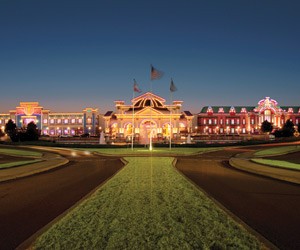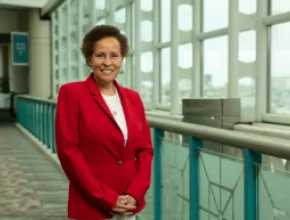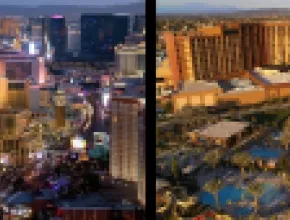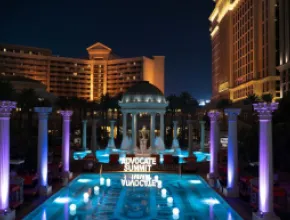With expanding resort components, particularly new multipurpose event centers, the South’s ever-evolving casino landscape continues to offer new opportunities for meetings.
In 2010, gaming destinations along Mississippi’s Gulf Coast were facing possible fallout from the Deepwater Horizon oil spill, which had just been capped. A year later it is the Magnolia State’s riverfront casinos that have been grappling with unforeseen circumstances—the result of spring floods that played havoc with tourism.
Oklahoma has moved ahead to become second only to California in Native American gaming revenue. Like Florida, its Native American casinos have benefited in recent years by a move from electronic bingo-type gaming machines to Las Vegas-style slots and house-banked table games.
Major expansions of Native American gaming resorts are under way in Louisiana and North Carolina, while new large-scale commercial casino resorts have been announced for Lake Charles, La., and Biloxi, Miss.
Mississippi has opened its second Native American gaming destination. West Virginia’s first permanent gaming facility that’s not at a racetrack recently completed its first year of operation, and all its racetrack casinos now boast hotels and table games.
Mississippi
Mississippi is the South’s top commercial (non-Native American) gaming state in casino revenues, with Louisiana not far behind. Consumers spent $2.39 billion on gaming at its 30 casinos last year, a 3.2 percent drop from 2009, when there was a 5.9 percent decline from 2008, according to figures from the American Gaming Association.
Of the Magnolia State’s 30 casinos, 19 are along the Mississippi River in a handful of communities and 11 are on the Gulf of Mexico. All but two of the 19 riverfront casinos were closed for periods running from late April well into June, some for more than a month.
Tunica, the river’s biggest market, boasts nine gaming resorts, three championship golf courses and 6,300 hotel rooms. During the historic rising of the Mississippi waters, casinos, including 4,600 hotel rooms, were closed down between April 27 and May 2, but all reopened before the Memorial Day weekend.
However, the two hotels at the 1,356-room Harrah’s Casino Tunica, the primary meetings venue, did not have to close. Its Mid South Convention Center with over 45,000 square feet of rentable space also remained open, as did its golf course.
According to Webster Franklin, Tunica CVB president and CEO, meeting and convention business held up, with some groups booked at the closed hotels moving to Harrah’s.
“May was the worst month in our history,” he says. “Now we’re back and we’ve been getting the word out. We were able to show people how resilient Tunica truly is. Basically the gaming facilities were closed for three weeks, and in some cases four, but there was very little infrastructure damage inside them.”
Aside from Harrah’s, other major meetings properties in Tunica include the 1,260-room Gold Strike Casino Resort, which has 30,000 square feet of meeting space, and the 1,076-room Sam’s Town, which has 50,000 square feet. In addition to Harrah’s, Caesars Entertainment also operates the 500-room Horseshoe Tunica and the 134-suite Tunica Roadhouse Casino & Hotel.
Farther south, Vicksburg has five riverside casinos, all with hotels. Two of them, Riverwalk and Ameristar, remained open, while two others, Rainbow Hotel Casino and DiamondJacks, closed for a few weeks during the floods.
Under new ownership, the Grand Station Hotel & Casino, formerly called Horizon, closed in March for remodeling and rebranding, then reopened in early June. It is the only gaming hotel close to the Vicksburg Convention Center.
According to the Vicksburg CVB, the floods did not affect most of the major tourist attractions, including Vicksburg National Military Park and antebellum homes.
In Greenville, there are two riverboat casinos, Bayou Caddy’s Jubilee and Lighthouse Point. Greenville also has a land-based gaming facility, the105-room Harlow’s Casino Resort & Hotel, which includes a 2,600-seat entertainment center. In December, Churchill Downs bought the property.
Mississippi’s Gulf Coast encompasses 60 miles of coastline, including 26 miles of beach and more than 20 golf courses. Nine of its 11 casinos are in Biloxi and Harrison County while two are to the west in Hancock County.
Following the oil spill in April last year, the CVB quickly announced that the coast remained opened for business. According to Crystal Johnson, director of sales at the Mississippi Gulf Coast CVB, damage to beaches has been minimal.
“We are excited to see our meetings facilities growing to accommodate the groups that are interested in meeting on the Gulf Coast,” she says, referring to Biloxi’s expanded Mississippi Coast Coliseum & Convention Center, new attractions and hotel enhancements.
The convention center’s recent $118 million expansion and renovation increased its meeting and exhibit size from 180,000 to 413,000 square feet, enabling it to accommodate groups of up to 6,000 people.
At the end of this month the Palace Casino Resort will wrap up a $45 million expansion and renovation, becoming the Mississippi Gulf’s first non-smoking gaming facility, featuring a new gaming floor, buffet, smokers’ lounge and 1,800 square feet of new meeting space.
Johnson says that the property will be able to accommodate meetings for the first time since 2005 when Hurricane Katrina destroyed most waterfront casinos and forced properties to move gaming operations inside their hotels, eliminating meeting space. Currently, nine of the 11 casinos have hotels, which account for 5,560 of the coast’s 13,000 rooms. Before Katrina the room count topped 17,000.
The area’s largest meeting properties are MGM Resorts International’s 1,740-room Beau Rivage Resort & Casino, with 50,000 square feet of meeting space, and the 1,088-room IP Casino Resort & Spa, with 37,379 square feet.
In June, Boyd Gaming announced it had agreed to acquire the IP and that it will spend $44 million on capital improvements.
Two new proposed gaming facilities are expected to break ground this year: the $450 million, 18-acre CanCan Casino Resort & French Village in D’Iberville and the $48 million Margaritaville Casino, which is to include an event center and marina, in Biloxi’s Back Bay.
The state’s major Native American gaming facility is the Mississippi Band of Choctaw Indians’ Pearl River Resort near Philadelphia. Pearl River has two hotels with casinos, the 571–room Golden Moon and the 500-room Silver Star, plus 16 restaurants, 40,000 square feet of meeting space, 36 holes of golf and a 140-room Hilton Garden Inn.
Louisiana
Not far behind Mississippi, Louisiana had commercial gaming revenues of $2.37 billion last year, down 3.7 percent from 2009. It has one land-based gaming facility, 13 riverboat casinos and four casinos at racetracks (racinos). It also has three Native American casinos.
A two-hour drive from Houston, Lake Charles is the South’s fifth largest commercial gaming market. It has two waterfront gaming resorts and one racino.
Lake Charles boasts a civic center with a 17,875-square-foot exhibition hall, plus Pinnacle Entertainment’s 1,000-room L’Auberge du Lac Hotel & Casino, with 28,000 square feet of meeting space, and the 400-room Isle of Capri, with 14,500 square feet. In nearby Vinton, Boyd Gaming operates the 250-room Delta Downs Racetrack & Casino, which has an 850-seat events center.
Last year, Pinnacle cancelled its proposed 400-room Sugarcane Bay, a gaming resort adjacent to the L’Auberge for which it had undertaken groundwork.
In February, the surrendered gaming license was awarded to Creative Casinos LLC to build its proposed $400 million Mojito Pointe casino resort next to L’Auberge. Work on the Caribbean-themed resort, which will include two hotels, is expected to begin this fall and be completed in late 2013.
“Mojito Point will further enhance our tourism product,” says Shelley Johnson, executive director at the Lake Charles/Southwest Louisiana CVB.
“Southwest Louisiana is a big drive market and we’re seeing regional meetings and corporate business pick back up significantly after the downshift in the economy,” she adds. “We’re also seeing a lot of military reunions, and associations are always good business for us.”
In summer 2012, Pinnacle expects to unveil its $357 million Baton Rouge riverfront gaming facility now under construction. The 201-room L’Auberge Casino & Hotel Baton Rouge will feature a 1,500-slot casino, table games, a poker room and a 1,400-seat event center.
Baton Rouge currently has two Mississippi riverboat casinos: the 1,000-slot Belle of Baton Rouge Casino, which is under the same ownership as the adjacent 300-room Sheraton Baton Rouge Convention Center Hotel, and Penn National Gaming’s 1,000-slot Hollywood Casino.
New Orleans, the South’s fourth-largest commercial gaming market, is home to the land-based 450-room Harrah’s New Orleans, which offers a 500-seat theater near the Morial Convention Center. The metro area has two riverboats: Treasure Chest, adjacent to Kenner’s 46,000-square-foot Pontchartrain Center, and Harvey’s Boomtown New Orleans, which has 4,000 square feet of meeting space.
Like Lake Charles, Shreveport and Bossier City draw heavily on Texas markets. Louisiana’s third-largest commercial market has five riverside casinos, all meetings-ready hotels.
In June, Paradise Casino LLC unveiled plans to build a 400-room Margaritaville Hotel and Casino with a 1,000-seat entertainment complex just north of Bossier City’s riverfront Louisiana Boardwalk Bass Pro Shops. Ground is slated to break early next year.
Two of the five existing riverfront casinos are within walking distance of the 350,000-square-foot Shreveport Convention Center: the 514-room Sam’s Town, with 18,000 square feet of meeting space, and the 403-room Eldorado, with 6,200 square feet. Across the river, Bossier City offers the 570-room DiamondJacks, which has 20,000 square feet of meeting space; the 188-room Boomtown; and the 600-room Horseshoe Casino & Hotel.
Louisiana has two land-based Native American casinos with hotels.
The Coushatta Tribe operates the Grand Casino Coushatta in Kinder, which has a 2,850-slot casino, 70 table games, 57,000 square feet of meeting space, six restaurants and an 18-hole golf course. Construction is under way on a 401-room hotel expansion expected to open in 2012 that will increase the room count to 950.
Marksville in Central Louisiana is the site of the Tunica-Biloxi Tribe’s 500-room Paragon Casino Resort featuring a 2,000-slot casino, 18-hole golf course and more than 75,000 square feet of function space, including a 2,600-seat showroom and an 8,000-square-foot ballroom.
Florida
Florida has eight Native American casinos, seven operated by the Seminole Tribe and one by the Miccosukee Tribe, and five racinos. It is the fourth-largest Native American gaming state in revenue after California, Oklahoma and Connecticut.
According to Casino City’s 2011 Indian Gaming Industry Report, Florida’s 2009 tribal gaming revenues totaled $2 billion, 10.4 percent over 2008 (compared with a 1 percent nationwide decline). This followed a 19 percent increase in 2008 over 2007.
Alan Meister, the report’s author and an economist with Nathan Associates, attributes this growth largely to a shift from Class II to Class III Indian gaming at Seminole casinos, which began in early 2008. Las Vegas-style slots replaced bingo-style gaming machines and such house-banked table games as blackjack and baccarat were installed, following a new agreement between the Seminoles and the state.
In return, the tribe pays increased state taxes. The total number of table games at Seminole casinos increased from 187 in 2007 to 429 in 2009.
The Seminoles’ seven casinos include two with hotels, both AAA Four Diamond resorts: the 500-room Seminole Hard Rock Hollywood and 250-room Seminole Hard Rock Tampa.
The other casino resort, the 302-room Miccosukee Resort & Gaming west of Miami, offers 1,700 Class II video pull-tab machines, 58 poker tables, a 1,200-seat high-stakes bingo hall, 46,000 square feet of meeting space and 27 holes of golf.
Voters approved racinos in Broward County in 2006 and Miami-Dade County in 2008. Miami-Dade’s two casinos are the 1,200-slot Calder Casino & Race Course and the 800-slot Magic City Casino at Flagler Dog Track.
Broward’s three casinos are the 850-slot Gulfstream Park, the 1,200-slot Mardi Gras Racetrack and Gaming Center and the 1,500-slot Isle Casino Racing Pompano Beach.
Oklahoma
Native American gaming took off in the Sooner State after 2005 legislation allowed each tribe to negotiate with the state to provide Class III slots and non-house-banked card games. While most gaming facilities in the state are small, growth has also resulted in a collection of new gaming resorts.
According to the 2011 Gaming Report, Oklahoma’s 2009 revenues—second only to California—totaled $3.1 billion in 2009, up 6.9 percent over 2008, which was up 18 percent over 2007.
The expansion of the Cherokee Casino & Resort in Catoosa outside Tulsa only six years ago marked the first gaming resort. It was rebranded the Hard Rock Hotel & Casino Tulsa two years ago, following the completion of a $155 million expansion that included a second hotel tower.
In May, the Cherokee Nation announced plans to begin construction on a third tower, which will add 100 rooms to the existing 356. The $52 million tower will also include more dining, entertainment and gaming space.
“Our success is based on our ability to provide great service, and what the customer wants and they have told us they want is more rooms,” says David Stewart, CEO of Cherokee Nation Entertainment. “Demand is high and our occupancy rates are in excess of 90 percent, so we’ve kind of outgrown our existing facility.”
The resort offers golf, a 2,300-slot casino with 70 table games and 35,000 square feet of meeting space that includes a 15,000-square-foot ballroom. The Joint, a 2,700-seat entertainment venue, opened last September.
Also in Tulsa, the Muscogee Nation opened its 2,600-slot River Spirit Casino in May 2009 and then added the 2,800-seat River Spirit Event Center last year.
Other casinos have expanded with hotels, including the Cherokee Casino West Siloam Springs, located east of Tulsa, which unveiled a 140-room hotel and 14,000 square feet of meeting space last year.
In Thackerville, the WinStar World Casino opened a 395-room hotel in August 2009, completing an expansion that included a 2,500-seat events center. The Choctaw Casino Resort Hotel & Conference Center in Durant completed a $300 million expansion last year that included a 330-room hotel.
In Quapaw, the Quapaw Tribe debuted the $300 million, 222-room Downstream Casino Resort three years ago.
It includes a 2,000-slot casino, a conference center with six rooms, a 6,200-seat outdoor concert venue and golf.
West Virginia
With four racetrack casinos with more than 11,500 slots, West Virginia is one of the country’s top racino states. Gaming revenues totaled $877.65 million last year, down 3.1 percent from 2009.
The Mountain State got its first permanent non-racino gaming facility in July last year with the unveiling of the $80 million Casino Club at The Greenbrier, a luxury 721-room resort in White Sulphur Springs offering 85,000 square feet of meeting space and three golf courses.
The Greenbrier’s new 102,000-square-foot gaming facility features a 320-slot casino with poker and table games, two restaurants, lounges and upscale retail boutiques. It replaced a smaller, temporary facility, the Tavern Casino, now used for function space.
The gaming facility is only open to overnight guests, members of the Greenbrier Sporting Club and the Greenbrier Golf and Tennis Club, and registered event/convention attendees staying off-property when more than 400 rooms are sold.
The state’s largest casino is Hollywood Casino at Charles Town Races in Charles Town in the Eastern Panhandle. It has a 5,000-slot casino, meeting space that includes a 5,200-square-foot ballroom and a 153-hotel that opened in 2008. Formerly called Charles Town Races & Slots, the facility was rebranded by Penn National Gaming last year.
Last year, the former Tri-State Racetrack and Gaming Center opened a 150-room hotel and was renamed Mardi Gras Casino & Resort. It can handle groups of up to 300.
The state’s two other racinos are in the Northern Panhandle. The 150-room Wheeling Island Hotel, Casino & Racetrack has conference rooms accommodating up to 300 people and a 1,000-seat showroom; the 359-room Mountaineer Casino, Racetrack & Resort in Chester has an 11,100-square-foot ballroom.
Other States
North Carolina’s one gaming resort is Harrah’s Cherokee Casino & Hotel, an enterprise of the Eastern Band of the Cherokee Nation located 50 miles west of Asheville at the entrance to Great Smoky Mountains National Park.
As part of a three-year, $633 million renovation and expansion, the property recently opened a 3,000-seat events center and third hotel tower, bringing its total room count to 1,108.
According to Carol Hawks Smith, group sales manager for the resort, the reception to the new tower has surpassed expectations.
“We’ve seen increases in group sales,” she says. “We are increasingly successful in our efforts to aggressively attract group business. The new tower nearly doubled our guest room capacity, so conference guests can remain all under one roof.”
Alabama’s newest AAA Four Diamond property is its only gaming resort, the Poarch Band of Creek Indian’s $250 million Wind Creek Casino & Hotel.
Opened near Atmore, 50 miles from Mobile, in early 2009, the property features a 236-room hotel, four restaurants and meeting and event space.
Caribbean
In February, construction began on the $3.4 billion Baha Mar Resort in Nassau, which will include a 200,000 square-foot convention center—the largest in the Bahamas. Slated to open in late 2014, the 1,000-acre gaming and entertainment complex will also boast four hotels, including two small luxury properties operated by Rosewood and Morgans, a 700-room Grand Hyatt and a 1,000-room casino hotel.
It will also include two existing hotels operated by Baha Mar Resorts, the Sheraton Nassau Beach Resort and Wyndham Nassau Resort.
On Bimini, the westernmost Bahamas island, RockResorts took over the management of the 350-room Bimini Bay Resort & Marina last March. The company announced plans for a gaming and boutique hotel.
Tony Bartlett has been writing for travel industry publications for over 20 years.






